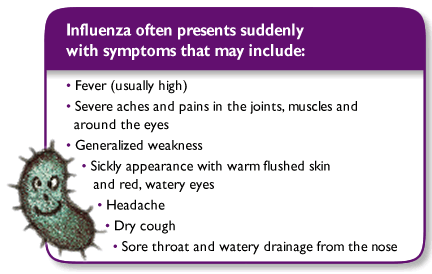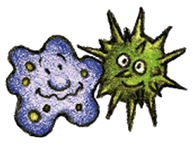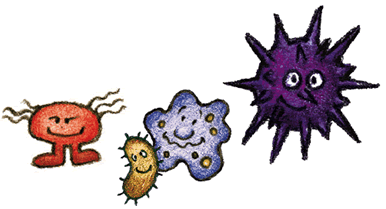Influenza or the “flu”
Karla Schlimgen, MD, FAAP
Pediatrics
OakLeaf Pediatrics
Eau Claire
This month the seasonal influenza vaccine will become available again and parents will have to decide whether to vaccinate themselves and/or their children.
 Influenza or “flu” is a sudden-onset respiratory illness caused by an Influenza A or B virus. It occurs in outbreaks each year—usually during the winter season in climates such as Wisconsin. It is often confused with “stomach flu” which is a separate viral illness involving vomiting and diarrhea. Last year became even more confusing when a new H1N1 Influenza A virus strain appeared in Mexico, spread to the United States and throughout the world. The influenza that this caused was called the Pandemic Flu, Swine Flu or 2009 H1N1 Flu.
It is estimated that 15–40% of children get the flu each year, while estimates are lower in the general population at 5–20%. Healthy children usually have a self-limited uncomplicated influenza illness; however, influenza at times causes severe complications and even death. Certain children are at high risk for developing severe or complicated influenza. These children at high risk include all children under the age of 5 years and children with chronic health problems such as asthma, seizure disorders,
heart defects and diabetes.
Influenza or “flu” is a sudden-onset respiratory illness caused by an Influenza A or B virus. It occurs in outbreaks each year—usually during the winter season in climates such as Wisconsin. It is often confused with “stomach flu” which is a separate viral illness involving vomiting and diarrhea. Last year became even more confusing when a new H1N1 Influenza A virus strain appeared in Mexico, spread to the United States and throughout the world. The influenza that this caused was called the Pandemic Flu, Swine Flu or 2009 H1N1 Flu.
It is estimated that 15–40% of children get the flu each year, while estimates are lower in the general population at 5–20%. Healthy children usually have a self-limited uncomplicated influenza illness; however, influenza at times causes severe complications and even death. Certain children are at high risk for developing severe or complicated influenza. These children at high risk include all children under the age of 5 years and children with chronic health problems such as asthma, seizure disorders,
heart defects and diabetes.
 Influenza causes a large disease burden each year with school and work absence and medical related costs. A recent estimate of the direct medical costs (including hospitalizations, doctor’s office visits, and medications) due to seasonal influenza in the United States each year is $4.6 billion. There are an estimated additional 111 million workdays lost due to sick days and lost productivity amounting to a loss of another $7 billion per year.
Influenza is spread in respiratory secretions from person to person by coughing, sneezing, talking and touching. Children are felt to be significant vectors for the spread of the disease. The best way to prevent seasonal flu is by getting a seasonal flu vaccination each year. The CDC (Centers for Disease Control) has recommended all children from 6 months to 18 years be vaccinated annually.
Influenza causes a large disease burden each year with school and work absence and medical related costs. A recent estimate of the direct medical costs (including hospitalizations, doctor’s office visits, and medications) due to seasonal influenza in the United States each year is $4.6 billion. There are an estimated additional 111 million workdays lost due to sick days and lost productivity amounting to a loss of another $7 billion per year.
Influenza is spread in respiratory secretions from person to person by coughing, sneezing, talking and touching. Children are felt to be significant vectors for the spread of the disease. The best way to prevent seasonal flu is by getting a seasonal flu vaccination each year. The CDC (Centers for Disease Control) has recommended all children from 6 months to 18 years be vaccinated annually.
“A recent estimate of the direct medical costs due to seasonal influenza in the United States each year is $4.6 billion.”
 There are two types of seasonal flu vaccine licensed by the FDA (Food and Drug Administration) for use in the United States: the trivalent influenza vaccine (TIV) and the live attenuated influenza vaccine (LAIV). The TIV is injected into the muscle of the upper arm or thigh and can be used in children as young as 6 months. The LAIV is given as a nasal spray and can be used for children 2 years of age and older. Both TIV and LAIV are contraindicated in people with egg allergy. Both these vaccines are also available without the controversial preservative thimerosal. The LAIV is also contraindicated in people with known or suspected immunodeficiency or an immune compromised state.
There are two types of seasonal flu vaccine licensed by the FDA (Food and Drug Administration) for use in the United States: the trivalent influenza vaccine (TIV) and the live attenuated influenza vaccine (LAIV). The TIV is injected into the muscle of the upper arm or thigh and can be used in children as young as 6 months. The LAIV is given as a nasal spray and can be used for children 2 years of age and older. Both TIV and LAIV are contraindicated in people with egg allergy. Both these vaccines are also available without the controversial preservative thimerosal. The LAIV is also contraindicated in people with known or suspected immunodeficiency or an immune compromised state.
 The seasonal flu vaccines are trivalent—meaning they contain three selected strains of influenza virus. These three strains are selected each year based on global surveillance for influenza viruses and the emergence and spread of new strains. The 2010-2011 seasonal flu vaccine will contain the 2009 H1N1 influenza strain.
The seasonal flu vaccines are trivalent—meaning they contain three selected strains of influenza virus. These three strains are selected each year based on global surveillance for influenza viruses and the emergence and spread of new strains. The 2010-2011 seasonal flu vaccine will contain the 2009 H1N1 influenza strain.
There are excellent sources for more detailed information available on–line such as Flu.gov and cdc.gov/flu. Your child’s physician can also help answer questions and address concerns you may have regarding the influenza and influenza vaccine.
Dr. Schlimgen – OakLeaf Pediatrics
For information or to schedule an appointment:
715-830-0732 | www.oakleafmedical.com
Dr. Schlimgen sees patients in Eau Claire.





 © 2009 OakLeaf Medical Network and OakLeaf Surgical Hospital. All rights reserved.
© 2009 OakLeaf Medical Network and OakLeaf Surgical Hospital. All rights reserved.